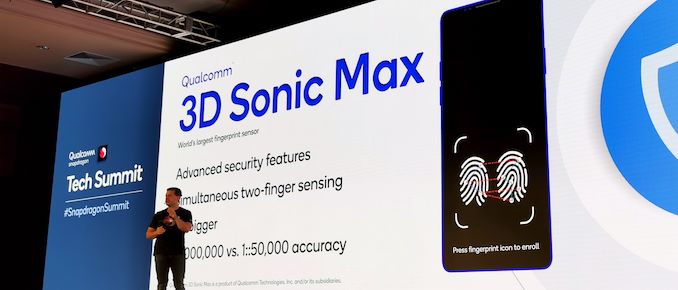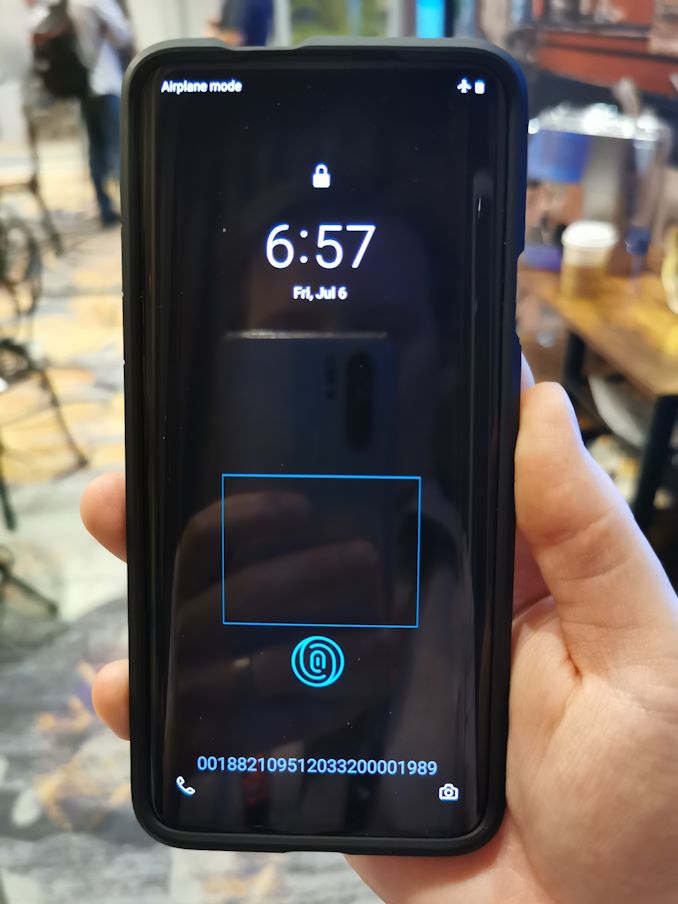This Smartphone Fingerprint Sensor Gets Two Thumbs (Up)
by Dr. Ian Cutress on December 30, 2019 12:00 PM EST
One of the cool features that came out of Qualcomm’s Tech Summit last month was its new fingerprint sensor. This one goes above and beyond anything I’ve seen before – where fingerprint sensors used to be small and have a sensing angle no bigger than a sesame seed, Qualcomm’s new 3D Sonic Max sensor is massive.
One of the key issues with modern high-end smartphones is fingerprint unlocking. Fingerprint sensors are found in one of three locations: the rear, the side (rare), or in the display. As we’ve gone through 2019, one fingerprint sensor company is promoting over 100 design wins for in-display fingerprint sensors. To be in the display, the sensor sometimes bonded to it, which causes concerns about z-height, but the main issue with in-display fingerprint sensors is the detection area.
Most in-display detection areas are quite small, often smaller than an actual thumb. And thus when a person tries to unlock the smartphone, they have to guess as to exactly where the sensor is. Given that the sensor is several millimetres wide, by being off 2-3 mm means that the likelihood of a positive unlocking is down to the quality of the sensor and the software. Some smartphones with always-on displays get around this by offering up a fingerprint area to show where you have to press, but even then that only gets displayed after you’ve touched the display once. Overall we can all agree on one thing: in-display sensors are too small.
Now it should be noted that there are two types of in-display sensor: optical and ultrasonic. Optical sensors rely on light to bounce between the fingerprint and the sensor, and this is achieved often by brightening the screen when a finger press is detected. With the right combination of hardware and software, a device might even be able to start detecting when something is about to press the sensor and anticipate it. The other type of sensor is ultrasonic, which doesn’t need light but does require direct contact. This looks at the return pattern by using ultrasonic waves through to the finger. A number of previous ultrasonic sensors have claimed superior security due to this.
So what makes Qualcomm’s new 3D Sonic Max so different? Well it’s freaking huge. It’s big enough for two fill thumbs to be used for detection at the same time.
The sensor size on the previous model was 4mm x 9mm. This time it is 20mm x 30mm, a full 16x larger than before, and as you can see from the image above, the actual detection area is slightly larger than that due to the detection methodology. The sensor can operate in single finger detection mode, or dual finger detection mode, requiring both fingers to be present when unlocking a device (make sure you don’t lose a finger). This sensor gets rid of that ‘small sensor’ problem, as a fingerprint can be detected anywhere inside that box.
Qualcomm didn’t disclose if this new sensor would cost more than their old Sonic fingerprint sensor, but it likely does. I suspect that the optical sensor companies, who control most of the market at this point, will have to make something on a similar scale in order to compete, as undoubtedly there will be one smartphone vendor brave enough to use Qualcomm’s solution in 2020, surely. Qualcomm also stated that their solution works not only in smartphones, but can also be enabled for automotive based on its security credentials. This is the point where we start our vehicles by jabbing at a large screen with our fingerprint and the system can tell who is driving.
Related Reading
- Synaptics' Next-Gen Fingerprint Sensor Security: The FS7600 Match-In-Sensor
- Synaptics at Computex: Encrypted and In-Display Fingerprint Sensors in Real Products
- Goodix Ships Optical In-Display Fingerprint Sensor for Smartphones
- Cherry Launches MC 4900 Mouse with Fingerprint Reader, 1375 DPI Sensor
- Synaptics Discusses Fingerprint Security and the Need For End-to-End Encryption
- Qualcomm Announces Snapdragon Sense ID Fingerprint Scanning











23 Comments
View All Comments
boeush - Monday, December 30, 2019 - link
I'd guess the dual-finger scenario is more likely targeting index+middle-finger, than two thumbs - just based on purely ergonomic considerations...StormyParis - Monday, December 30, 2019 - link
I'm still unsure if this is noticeable compared to a sensor on the back.Drumsticks - Monday, December 30, 2019 - link
Qualcomm better have a damn good market proven, security tested fingerprint reader before they jump into the automotive market. I don't think I'd be comfortable attaching a fingerprint reader to my car unless a bug bounty turns up goose eggs. I don't need a moderately tech savvy thief lifting fingerprints off of the outside of my vehicle and then driving off with it.RSAUser - Tuesday, December 31, 2019 - link
Would be for identification or basic authentication rather. So have the key to get into the car, fingerprint to actually start it (plus use normal key in radius detection). Would help with e.g. Trusting kid with keys if they have to get something from the car, or for profiles like maybe tying Spotify login or what Bluetooth device to connect to.s.yu - Monday, December 30, 2019 - link
Why not just use an array of small sensors then? They can be spaced in between and the result will be the same if not a larger detection area.Ian Cutress - Monday, December 30, 2019 - link
Cost? power? configuration?Thud2 - Monday, December 30, 2019 - link
It should be a thumb on the front with an Index finger in the same spot in the back.PeachNCream - Monday, December 30, 2019 - link
Pass on fingerprint authentication. Its one of those things I can NEVER change about myself so once it gets compromised, security would be pretty much boned forever and if that method of authentication is used on an Internet connected system, you can safely bet that it is only a matter of time before it gets compromised.Xyler94 - Tuesday, December 31, 2019 - link
If implemented correctly, your fingerprint data is never stored directly. It's more like a cryptographic version of your fingerprint. One phone's data on your fingerprint wouldn't (And really shouldn't) be the same. Just like a password on a website. If implemented correctly, and I've tested this for the fun of it, even using the same password on the same site can yield different hashes depending on the salt/pepper used, and the algorithm.Xyler94 - Tuesday, December 31, 2019 - link
*Correction. wouldn't and shouldn't be the same on another device... unless they used the exact same sensor and algorithms and whatnot.